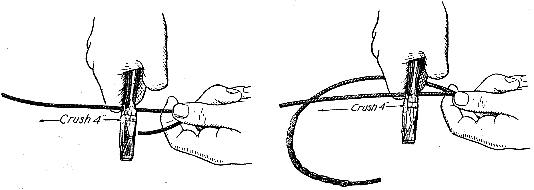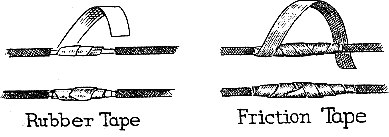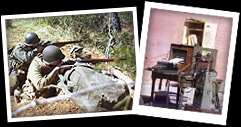The Field Wire Splice
From the
Camp Crowder Central Signal Corps School Workbook
Introduction:
A. Tools and Equipment:

Every soldier engaged in communication work should be able to
make a proper field wire splice. Occasions constantly arise in which such ability
is necessary. It is therefore important that the entire unit be trained for
this work.
In making splices there are three (3) important points that must be remembered.
If these points are wkept constantly in mind and religeously applied the resulting
splice will have all of the original qualities of the wire itself. These points
are:
1. Conductivity of the wire.must be maintained.
2. Insulation resistance must also be maintained.
3. Tensile.strength must not be materially decreased.
B. Making the Field Wire Splice.
1. Teamwork in Making the Splice——When making splices it often happens that there is more than one man available at the time the splice is being made. If this is the case, the over-all time for making the splice can be greatly reduced if tha two men have a standard cooperative method and function as a team.
2. Staggering the Splice——Each man prepares one of the two wires which are to be spliced together. To obtain a uniform stagger, each man measures back one plier's length (about six inches) from the end of one conductor of the wire he is preparing and cuts off the conductor thus measured. Each man now has two conductors, with one cut six inches shorter than the other:

3. Crushing the Insulation——Each man now begins crushing the insulation on his long conductor at the point where the short one ends, that is, one pliers length from the end of the long conductor. Using the heel of his pliers, he crushes the insulation toward the end for a distance of about four (4) inches, leaving two (2) inches of the insulation uncrushed on the end of the conductor. He next measures back one pller's length along the short conductor and repeats the operation. The uncrushed Insulation remaining on the ends of the conductors holds the strands together preventing possible injury to the splicer. The two operations give a uniform stagger which insures an equal tension on both conductors, eliminates bulklness and lessens the possibility of short circuits:

4 Skinning the Conductor----Each man grasps the wire with the heel of the pliers
at the point where crushing has begun. With a firm grip on the pliers he draws
his pliers along the wire. This leaves about three and one-half Inches (3 1/2)
of bare wire and one-half (1/2) inch of bare rubber insulation where the skinning
began:

5 Tying the Square Knot——-The ends of the two wires are now brought
together and the long conductor of one wire and the short conductor of the other
wire are tied in a square knot by each man. The square knot is so placed as
to leave a distance of about one-quarter (1/4) inch between the knot and the
rubber insulation. The weatherproof braid is then peeled back from the one-half
(1/2) inch of wire that was crushed but not skinned. This leaves one- half (1/2)
inch of exposed rubber insulation to permit close adhesion of the rubber tape
when it is applied:

6, Applying the Seizing Wire——-A piece of seizing wire (six to eight
inches long) is inserted up through the square knot and the knot is pulled tight.
The seizing wire is bent so as to have one-half for wrapping to the left and
one-half for wrapping to the right. Two or three close turns are taken to the
right and left of the square knot. This binds the ends of the knot. The excess
ends of the conductors are now cut off even with the rubber insulation. Continue
wrapping the seizing wire both to the right and left of the square knot until
two turns have been taken on the rubber insulation. The remaining ends of the
seizing wire are cut off evenly and pressed down into the rubber. With both
men tying the square knots and applying the seizing wire at the same time, the
over-all time should not be in excess of one minute.

7. Applying the Rubber Tape——-For best results and ease of application, the wire is held taut when the rubber tape is being applied. One man holds the wire taut while the other applies two (2) layers of rubber tape to the splice. The taping is started in the center of the splice and is worked to the left and right of the knot for a distance of one-half (1/2) inch on the rubber insulation. The rubber tape is stretched considerably so as to give close adhesion, and is pressed into intimate contact with the rubber insulation on both ends of the splice to keep it waterproof:

8. Applying the Friction Tape——With one man holding the wire taut, the other man applies two layers of friction tape over the rubber tape. The friction tape is extended about one inch beyond the rubber tape. This gives an overall taped splice of about four (4) inches. The finished splice is then rolled several times between the hands to seal the edges. The splice is now complete.


